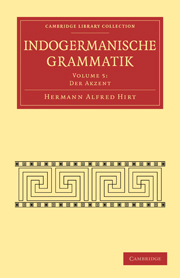Book contents
- Frontmatter
- Vorwort
- Contents
- Einleitung
- Erster Teil. Der Akzent der Einzelsprachen
- Zweiter Teil. Der Akzent des Indogermanischen
- XVI Kapitel. Die Intonation (der Silbenakzent)
- XVII Kapitel. Derindogermanische Wortakzent (Hauptton)
- XVIII Kapitel. Typus mit wechselndem Ton
- XIX Kapitel. Nomina mit festem Ton
- XX Kapitel. Betonung der Adjektiva
- XXI Kapitel. Adverbium. Zahlwort. Pronomen
- XXII Kapitel. Betonung des Verbs. Vorbemerkungen
- XXIII Kapitel. Die einzelnen Betonungstypen des Verbums
- XXIV Kapitel. Der zweite Betonungstypus
- XXV Kapitel. Der dritte Betonungstypus
- XXVI Kapitel. Der Satzakzent. Vorbemerkungen
- XXVII Kapitel. Enklise und Proklise
- XXVIII Kapitel. Betonung der Wortgruppen
- XXIX Kapitel. Die weitere Satzbetonung
- Autorenverzeichnis
- Sachregister
- Wörterverzeichnis
XXIII - Kapitel. Die einzelnen Betonungstypen des Verbums
Published online by Cambridge University Press: 05 August 2011
- Frontmatter
- Vorwort
- Contents
- Einleitung
- Erster Teil. Der Akzent der Einzelsprachen
- Zweiter Teil. Der Akzent des Indogermanischen
- XVI Kapitel. Die Intonation (der Silbenakzent)
- XVII Kapitel. Derindogermanische Wortakzent (Hauptton)
- XVIII Kapitel. Typus mit wechselndem Ton
- XIX Kapitel. Nomina mit festem Ton
- XX Kapitel. Betonung der Adjektiva
- XXI Kapitel. Adverbium. Zahlwort. Pronomen
- XXII Kapitel. Betonung des Verbs. Vorbemerkungen
- XXIII Kapitel. Die einzelnen Betonungstypen des Verbums
- XXIV Kapitel. Der zweite Betonungstypus
- XXV Kapitel. Der dritte Betonungstypus
- XXVI Kapitel. Der Satzakzent. Vorbemerkungen
- XXVII Kapitel. Enklise und Proklise
- XXVIII Kapitel. Betonung der Wortgruppen
- XXIX Kapitel. Die weitere Satzbetonung
- Autorenverzeichnis
- Sachregister
- Wörterverzeichnis
Summary
Typus 1. Der Typus 1 zeigt Betonung der Endungen, mit Ausnahme der drei ersten Personen des aktiven Singulars.
Dies ist die Grundtatsache, von der allerdings kleine Abweichungen vorkommen.
1. Bei den reduplizierten Präsentien ruht in der 3. Pl. der Ton auf der Doppelungssilbe, z. B. ai. bí-bhj-ati. Daβ dieses alt ist, werden wir weiter unten sehen.
2. Die 2. Plur. Imperativ auf -ta oder -tana hat im Indischen nicht selten Vollstufenvokalismus und Betonung der ersten Silbe, z. B. dháta, gánta, jánta, kárta, éta, śróta, sōta.
3. Auch die Formen auf -dhi haben zuweilen Vollstufenvokalismus, dabei allerdings Endbetonung, vgl. ai. bōdhí, jōdhí, jujōdhí, pāhi.
Man sieht daraus, daß die Betonung nicht ganz fest war. Zu diesem Typus gehören:
1. die athematischen Präsentien, aind. zweite Klasse;
2. die reduplizierten athematischen Präsentien, indische dritte;
3. die nasalierten Präsentien; 4. das Perfektum; 5. der s-Aorist; 6. der Optativ.
Die athematischen Präsentien. Alle athematischen Präsentien haben im Indischen den angegebenen Tonwechsel. Vollstufe mit e-Vokalismus und Wurzelbetonung im Sing. des Ind. Präs., sonst Schwundstufe und Endbetonung gehen Hand in Hand:
z. B. 1. Sg. dvéšmi, 1. Pl. dvišmás, 3. Pl. dvišánti; ásmi, smás, sánti und im Medium dvisé, dviksé, dvisṭé.
Der 3. Plur. dvisánti sollte im Medium *dvišaté aus *dvišnté entsprechen, es heißt aber dvišátē. Hier hat offenbar eine Tonverschiebung stattgefunden, vgl. § 130.)
- Type
- Chapter
- Information
- Indogermanische Grammatik , pp. 303 - 311Publisher: Cambridge University PressPrint publication year: 2009First published in: 1929



